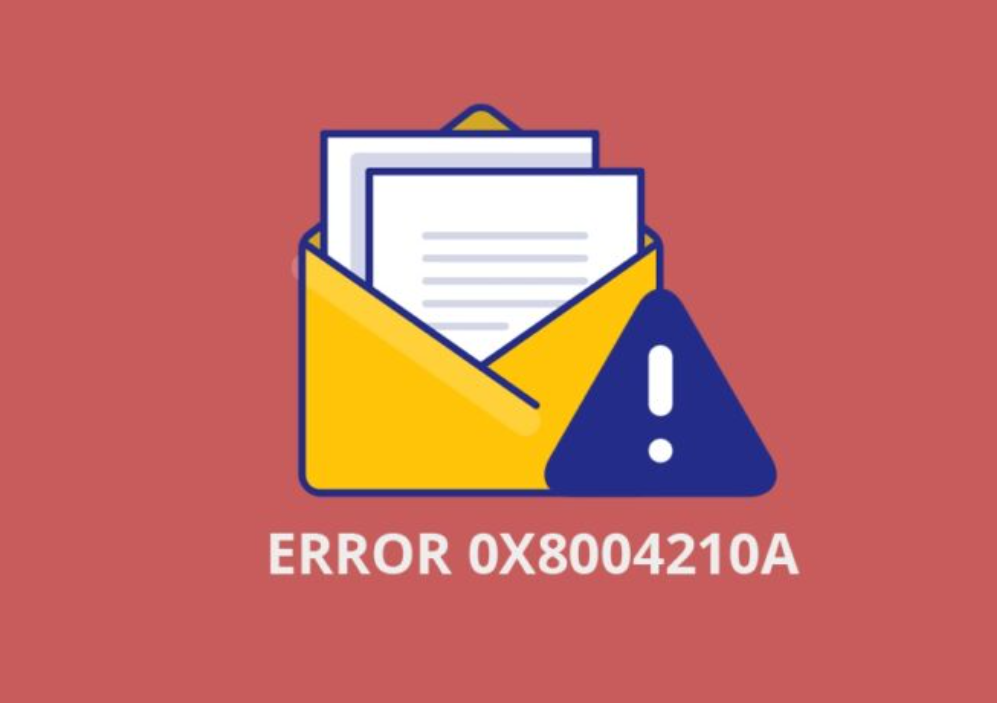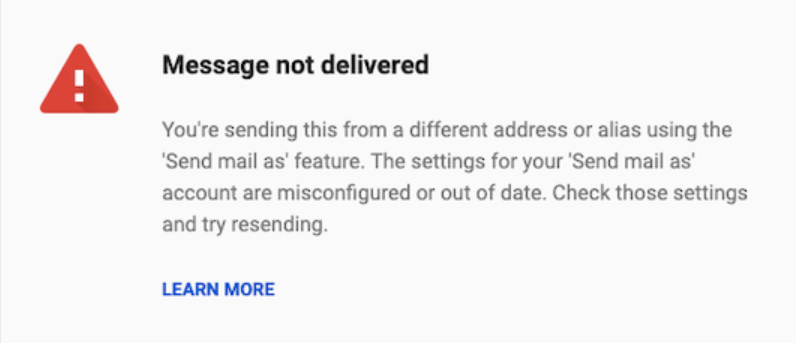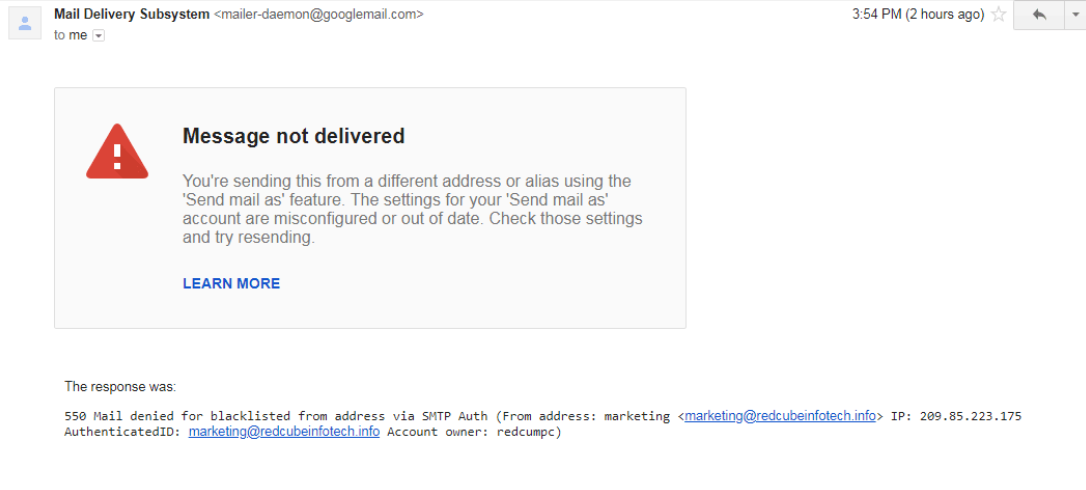There’s nothing more frustrating in the digital world than sending out an important mail only to receive an immediate notification saying “Mail Delivery Failed: returning message to the sender.” This message can disrupt your workflow, cause delays, and even lead to missed opportunities. But worry not, for there are ways to tackle this issue head-on. In this blog post, we will guide you through understanding, preventing, and resolving the dreaded ‘Mail Delivery Failed’ error, ensuring your emails reach their intended recipients without a hitch.
Understanding the ‘Mail Delivery Failed’ Message
When an email fails to reach its intended destination, the sender is typically notified with a ‘Mail Delivery Failed’ message. This automated response originates from the recipient’s email server, signaling a delivery problem. The reasons provided within these messages are crucial for identifying the root cause of the failure. They can vary widely – from simple errors like typing an email address incorrectly to more complex issues such as the recipient’s inbox being full or the email being mistakenly flagged as spam.
The specific error code or message contained within the failure notice holds the key to what went wrong. It’s essential to scrutinize these details, as they guide the troubleshooting process. For instance, a ‘550 5.1.1’ error might indicate a nonexistent email address, while a ‘552 5.2.2’ error suggests the recipient’s mailbox is over its quota. This underlying investigation is basic, permitting shippers to make informed strides towards redressing the issue and it is effectively conveyed to guarantee future messages. Grasping these messages helps in quick goals as well as illuminates better practices for future mailings, diminishing the probability of repetitive conveyance disappointments.
Common Causes of Email Delivery Failures
One of the primary reasons for email delivery failures is an incorrect email address entered by the sender. A simple typo can reroute an email to the void, never reaching its intended target. Beyond the basic error of misspelling, delivery failures often occur due to issues on the recipient’s end. For example, the server responsible for handling their emails could be experiencing downtime or technical difficulties, obstructing the email’s journey.
Another frequent culprit is a full mailbox; when the recipient’s email storage has hit its limit, new messages can’t be delivered until space is freed up. Additionally, an email’s content, attachments, or even the sender’s email address itself might trigger spam filters, causing the email to be diverted away from the recipient’s main inbox, or in some cases, blocked entirely.
Understanding these common causes is pivotal in navigating the complex web of email delivery and in crafting strategies to avoid these pitfalls. Identifying and addressing the specific reason behind an email’s failure to deliver not only rectifies the immediate issue but also fortifies the sender’s approach to email communication, paving the way for smoother, more successful email exchanges in the future.
How to Prevent Email Delivery Failures
Preventing email delivery failures begins with meticulous attention to the recipient’s email address. Ensuring accuracy at this fundamental level can avert a large percentage of failed deliveries. Regular maintenance of your email list is also critical; purging invalid or outdated addresses helps maintain the integrity of your campaigns and communications. To further minimize the risk of being flagged as spam, crafting emails with relevant, engaging content is key. Compliance with anti-spam legislation by including an unsubscribe option and identifying yourself or your organization is not just a legal requirement, but it also fosters trust with your recipients.
Encouraging your audience to whitelist your email address offers a proactive approach to ensuring your messages land in the inbox as intended. In like manner, understanding the specialized side of email sending, for example, validating your email space through SPF, DKIM, and DMARC records, can essentially support your email’s possibility of staying away from spam channels. Laying out a predictable sending design and keeping away from unexpected spikes in email volume can likewise assist with keeping a positive shipper notoriety.
Commitment is one more fundamental viewpoint; consistently exploring and improving in light of beneficiary cooperation can offer bits of knowledge into what content resounds, further refining your way of dealing with staying away from future conveyance traps. By taking on these protection measures, you’re tending to potential conveyance gives head-on as well as upgrading the general quality and adequacy of your email interchanges.
Steps to Resolve ‘Mail Delivery Failed’ Errors
Upon encountering a ‘Mail Delivery Failed’ error, your initial action should be to scrutinize the error message for specific clues pointing to the delivery issue. If the problem stems from an incorrectly entered email address, a careful review for typos or inaccuracies is necessary. In instances where the recipient’s email system is identified as the source of the problem, such as server downtimes or full inboxes, reaching out via an alternate communication method may be required to alert them of the issue.
For emails flagged as spam, assessing your email’s content, formatting, and attachment size is crucial. Adjustments may include simplifying the email structure, reducing attachment sizes, or modifying content to ensure it aligns with spam filter criteria. It’s also advisable to check that your email practices adhere to guidelines designed to bypass spam filters, including verifying that your email server’s technical settings are correctly configured.
In situations where adjustments to the email or sender practices do not resolve the delivery issue, it might be necessary to consult with the recipient’s IT department or your own IT support to explore deeper technical resolutions, such as modifying DNS settings or investigating potential blacklisting of your domain by major email providers.
When to Seek Professional Help
Encountering persistent ‘Mail Delivery Failed’ messages can be a clear sign that deeper issues are at play, which may not be solvable with general troubleshooting methods. This is particularly true if you’ve diligently followed the steps for resolving common causes of email failures, yet continue to face the same challenges. At this juncture, involving experts becomes crucial.
IT experts or email showcasing experts have the instruments, information, and experience to dig further into the complexities of email frameworks and recognize hidden issues that could get away from a layman’s notification. They can give an exhaustive investigation of your email framework, including examining your space’s standing and guaranteeing that your email specialist co-op is working ideally.
Besides, these specialists can offer high-level arrangements, for example, reconfiguring your email settings, exhorting on the prescribed procedures for keeping a sound space notoriety, or in any event, mediating straightforwardly with email specialist organizations to address boycotting issues. Engaging with professionals is not merely about fixing current problems but also about strategizing to prevent future issues, and ensuring a smooth and reliable email communication channel for your business or personal needs.
Best Practices for Email Management
It’s vital to adopt a proactive and organized approach to optimize your email management and mitigate delivery failures. Regularly cleaning your email list ensures you’re only sending emails to active, valid addresses, thus reducing bounce rates. Fragmenting your crowd can likewise upgrade commitment by fitting your substance to meet the particular requirements and interests of various gatherings, making your messages more applicable and less inclined to be set apart as spam.
Customizing your messages not only cultivates a more grounded association with your beneficiaries yet in addition improves the probability of your messages being opened and perused, further hardening your source notoriety. Picking a legitimate email specialist co-op assumes an essential part in this cycle, as they frequently have underlying devices and assets to assist with dealing with your email crusades successfully and exploring any deliverability issues.
Moreover, watching out for your email deliverability rates is fundamental. Observing for any abrupt changes or examples in conveyance disappointments can give early admonition indications of likely issues, permitting you to address them proactively before they influence your more extensive email technique. Implementing these best practices not only streamlines your email management processes but also lays a strong foundation for successful and efficient email communication.
Conclusion
Navigating through the challenges of a ‘Mail Delivery Failed’ message can seem daunting at first, but it’s a hurdle that can be overcome with the right strategies and approaches. A basic initial step is to dive into the particulars of the disappointment message, using this data to pinpoint and resolve the hidden issues. Embracing preventive estimates, for example, checking email addresses, keeping a spotless email list, and making content that meets hostile to spam models are fundamental practices that can radically reduce the event of such mistakes.
Should challenges endure, looking for the mastery of IT experts or email-promoting experts can give a more profound investigation and more custom-made arrangements, guaranteeing that your messages arrive at their planned targets. It’s critical to see these difficulties not just as obstructions but as any open doors to refine your email the executives and correspondence methodologies, in this way upgrading the viability of your computerized collaborations. With a proactive mentality and a guarantee of nonstop improvement, you can guarantee that your email correspondences are both dependable and effective, supporting your general outcome in the computerized domain.


